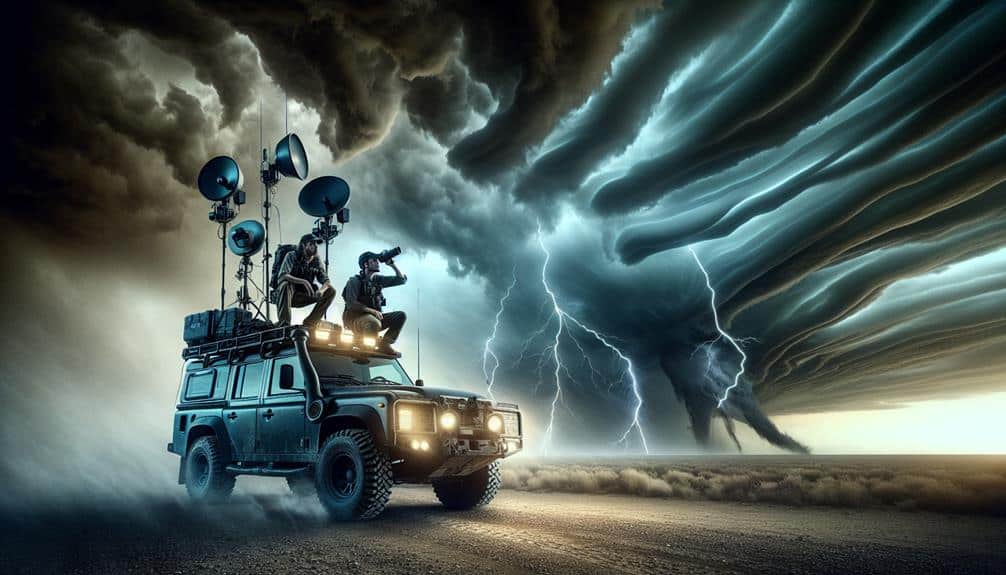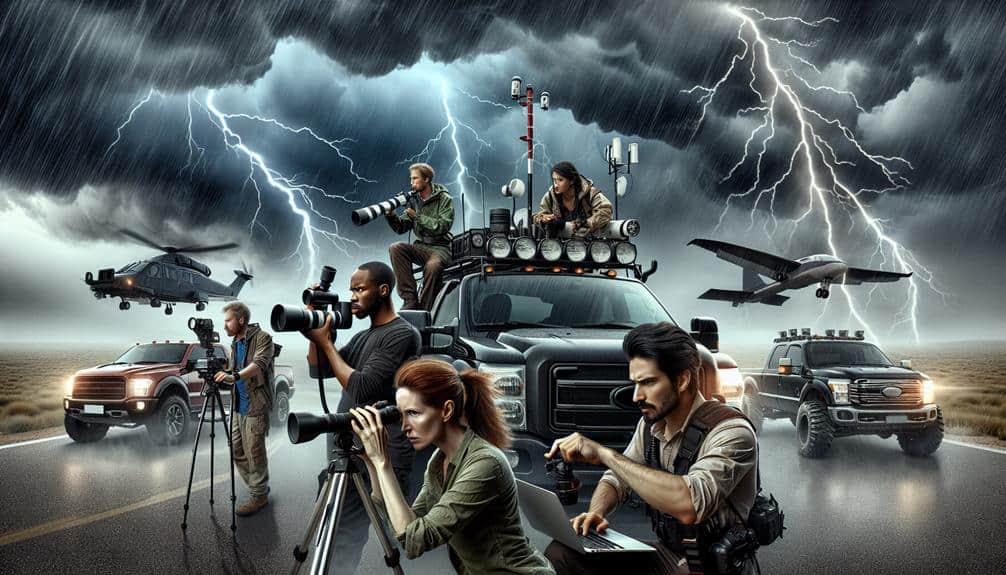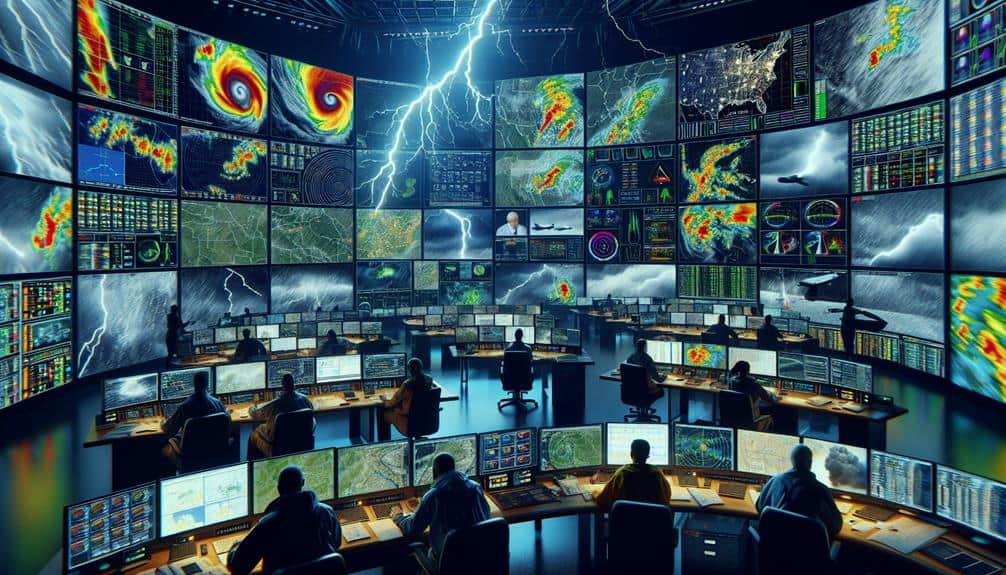When we're storm chasing, the right gear is essential for safety and efficiency. We need protective clothing with layered, moisture-wicking, and breathable materials like Gore-Tex. Our footwear should be weather-resistant with strong traction to prevent slips. Reliable communication is guaranteed by weather radios with long battery life and elevated antennas. GPS devices with superior signal reception and emergency supplies like first aid kits and water storage are indispensable. Our camera equipment must be weather-sealed to capture high-quality images in harsh conditions. Staying well-prepared will optimize our safety and success during storm pursuits, providing deeper insights ahead.
Key Points
- Wear breathable, layered clothing with moisture-wicking base and Gore-Tex outer layers.
- Use weather-resistant, waterproof footwear with good traction and proper fit.
- Carry a weather radio with long battery life and satellite communication.
- Utilize GPS devices with superior signal reception and long-lasting batteries.
Protective Clothing
How can we guarantee our protective clothing effectively shields us from the hazards of storm chasing?
To optimize protection, we need to focus on layering options and breathable fabrics. Layering allows us to adjust to varying weather conditions and maintain ideal body temperature. A base layer made of moisture-wicking material keeps our skin dry, reducing the risk of hypothermia. An insulating layer, such as fleece, retains body heat while being lightweight and easy to pack.
Breathable fabrics are essential for the outer layer. Materials like Gore-Tex or eVent provide a waterproof yet breathable barrier, preventing rain from penetrating while allowing sweat to escape. This balance is crucial in avoiding overheating and maintaining comfort during intense physical activity. Studies show that high-performance breathable fabrics can reduce sweat retention by up to 30%, enhancing our overall endurance.
In addition, our clothing should include features like adjustable cuffs, hoods, and ventilation zippers to customize our protection based on immediate needs. By using scientifically-backed layering options and breathable fabrics, we can confidently face the unpredictable nature of storm chasing, ensuring safety without compromising our freedom to explore.
Sturdy Footwear
When considering sturdy footwear, we must prioritize weather-resistant materials to withstand harsh conditions.
Ensuring a proper fit is essential to prevent injuries and maintain comfort during long hours of activity.
Additionally, shoes with excellent traction enhance our safety by reducing the risk of slips and falls on various terrains.
Weather-Resistant Materials
Sturdy footwear with weather-resistant materials is necessary for storm chasers to maintain traction and protect their feet in extreme conditions. When we're out in the field, we rely on our equipment to keep us safe, and our footwear is no exception.
High-quality boots made from weather-resistant materials like Gore-Tex or neoprene offer both waterproofing and breathability, ensuring our feet stay dry and comfortable. This is important as wet feet can lead to blisters, hypothermia, or even frostbite in cold conditions.
Data shows that weather-resistant footwear significantly reduces the risk of slips and falls, which is crucial when maneuvering rough terrains. Our choice of footwear should also complement other essential gear, such as waterproof cameras and durable backpacks.
These items collectively enhance our mobility and readiness, allowing us to focus on capturing critical storm data and staying safe.
Proper Fit Importance
Ensuring our footwear fits correctly is vital to prevent injuries and optimize performance during storm chasing. Proper sizing is essential because poorly fitting shoes can result in blisters, foot pain, and even long-term damage. By selecting footwear that fits well, we notably reduce the risk of injury and guarantee that we can react quickly and effectively in dynamic storm environments.
Comfortable wear is another key factor. We often spend long hours on our feet, traversing challenging terrain. Footwear that doesn't fit well can cause discomfort, which can divert us from our main goal—staying safe while collecting crucial data. Properly fitted shoes offer the necessary support and cushioning to keep us focused and nimble.
To guarantee a proper fit, we should consider the following:
- Measure both feet: Feet can differ in size, so measure both and select the size that fits the larger foot.
- Try on shoes with storm gear: Wear the socks and any insoles or orthotics you'll use while storm chasing.
- Check toe space: There should be approximately a thumb's width of space between your longest toe and the front of the shoe.
Traction for Safety
Having reliable grip on our footwear is essential for maintaining stability and preventing slips during storm chasing. The terrain we encounter can range from muddy fields to wet asphalt, making high-traction, sturdy footwear a non-negotiable part of our gear.
According to a study by the National Safety Council, slips, trips, and falls account for over 20% of non-fatal injuries. As a result, investing in footwear with robust tread patterns and durable materials significantly diminishes our risk.
In addition to traction, our shoes need to provide support for long periods of activity. Lightweight but sturdy hiking boots often strike the right balance, offering both grip and comfort. If we're moving through debris, steel-toe options can provide extra protection.
We must also consider how our footwear integrates with the rest of our safety gear, like survival kits and tools for direction. Quick mobility is crucial when seeking emergency shelters or using communication devices to coordinate with our team. Hence, our footwear should facilitate swift, stable movement without sacrificing safety.
Weather Radios
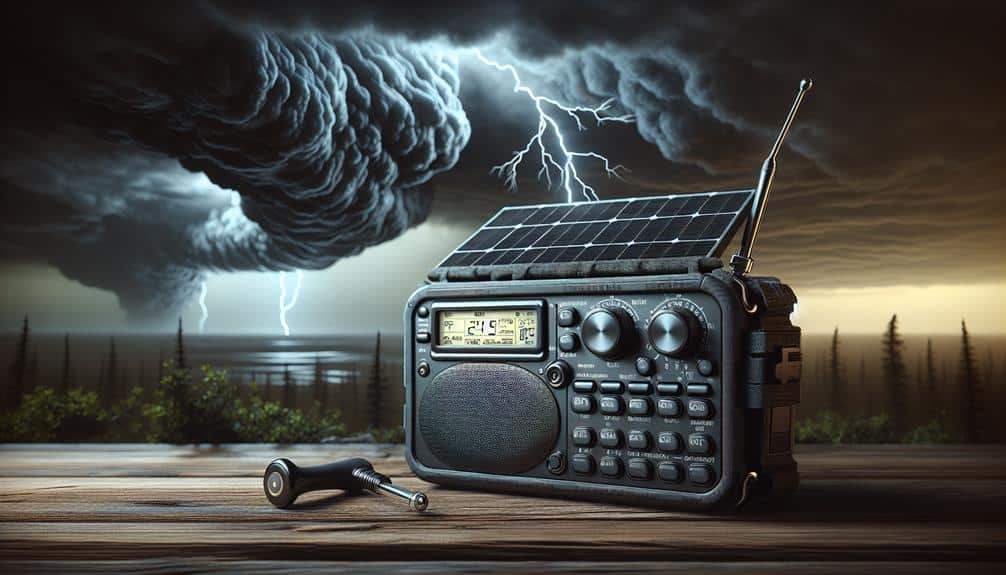
When we rely on weather radios, we need to make sure they provide dependable signal reception to stay informed about storm conditions.
Battery life is essential as we often find ourselves in locations without access to power.
Additionally, a portable design enhances our mobility and allows us to respond promptly to changing weather patterns.
Reliable Signal Reception
For storm chasers, maintaining reliable signal reception through weather radios is essential for accessing real-time updates and guaranteeing safety. Our ability to receive accurate information hinges on several key factors that enhance our signal reception capabilities.
First, optimizing antenna height is pivotal. Elevating the antenna can greatly improve signal strength, allowing us to capture transmissions from distant weather stations. The higher the antenna, the better the reception we can achieve, even in remote areas.
Second, integrating satellite communication can provide an additional layer of reliability. Unlike traditional radio signals, satellite transmissions are less prone to interference from natural obstacles, ensuring we receive continuous updates and emergency alerts regardless of our location.
Moreover, ensuring our weather radios are equipped to handle emergency alerts is essential. These alerts provide critical, time-sensitive information about severe weather conditions, helping us make informed decisions quickly.
To enhance our signal reception, consider the following:
- Optimize antenna height: Position the antenna as high as possible.
- Utilize satellite communication: Invest in radios with satellite capabilities.
- Regularly test signal strength: Guarantee consistent reception.
Battery Life Importance
Ensuring our weather radios have a long battery life is necessary for sustained operation during extended storm-chasing missions. In the fast-paced environment of storm tracking, we can't afford to be caught off-guard by a dead battery. Studies show that high-quality weather radios with extended battery life can operate up to 48 hours continuously, providing us with critical updates on weather patterns and storm movements.
This continuous feed of information is essential when we're out in the field, often far from fixed power sources. Data from multiple storm-chasing expeditions indicate that the risk of being without important weather information increases significantly if our devices lack sufficient battery life. Our safety and the success of our mission rely on the uninterrupted operation of these radios.
When selecting weather radios, we should prioritize those with proven battery longevity. Models featuring energy-efficient technology and low-power consumption modes are particularly advantageous. Moreover, rechargeable batteries with high mAh ratings offer a sustainable solution, reducing the need for frequent replacements.
Portable Design Benefits
A portable design in weather radios greatly enhances our mobility and responsiveness during storm-chasing missions. By opting for radios that prioritize compact storage and easy transportability, we can move swiftly and adapt to rapidly changing conditions. These radios fit seamlessly into our gear bags without adding unnecessary bulk, ensuring we're always prepared without feeling weighed down.
Lightweight construction further contributes to our enhanced mobility. A weather radio that's easy to carry allows us to focus on the storm rather than our equipment. This freedom of movement is pivotal when seconds matter, and every decision can impact our safety.
Here are key benefits of portable weather radios:
- Compact storage: Minimal space required in gear bags.
- Easy transportability: Simple to move from one location to another quickly.
- Lightweight construction: Reduces physical strain, allowing for greater agility.
Data-driven choices in our gear selection, like opting for portable weather radios, empower us to chase storms effectively while prioritizing our safety. By maintaining a balance between preparedness and freedom of movement, we can better navigate the unpredictable nature of storm chasing.
First Aid Kits
Every storm chaser should carry a well-stocked first aid kit to address potential injuries and emergencies in the field. Our unpredictable environment demands preparedness, and a thorough first aid kit is an essential component of our safety gear. First aid training equips us with the skills for effective emergency response, allowing us to act swiftly and confidently when accidents occur.
A well-equipped first aid kit should include medical supplies for proper wound care, such as adhesive bandages, antiseptic wipes, gauze pads, and medical tape. These items are vital for treating cuts, abrasions, and other minor injuries immediately, which can prevent infections and complications. Additionally, we should stock our kits with tweezers, scissors, and gloves to guarantee safe and hygienic treatment.
In more serious situations, having items like a CPR mask, a tourniquet, and an emergency blanket can make a significant difference in stabilizing a victim until professional help arrives. Our kits should also contain over-the-counter medications such as pain relievers, antihistamines, and anti-inflammatory drugs to manage symptoms and enhance comfort.
GPS Devices
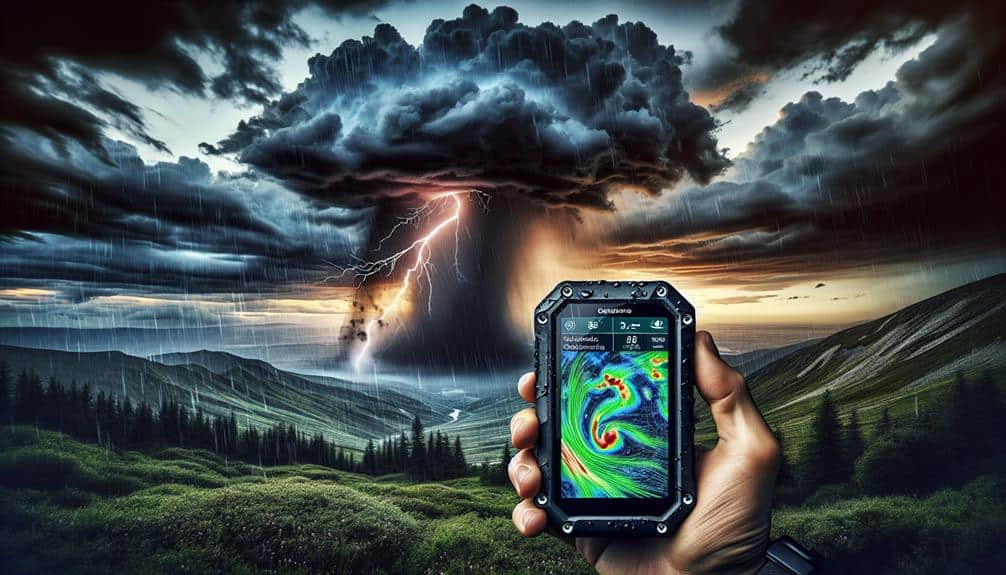
Reliable GPS devices are essential for storm chasers, providing accurate location data and direction assistance in rapidly changing environments. We need these devices to make sure we can track storms effectively and steer away from dangerous areas swiftly. A high-quality GPS device is indispensable for maintaining situational awareness and ensuring our safety.
When selecting a GPS device, we should consider the following factors:
- Battery life: Long-lasting battery life is vital since storm chasing can keep us in the field for extended periods. A device that can last the entire day without needing a recharge enhances our operational efficiency.
- Signal reception: Superior signal reception ensures we maintain connectivity even in remote areas where cell signals may be weak. This is important for receiving real-time updates and accurate direction.
- Portable design: A compact and lightweight design allows us to carry the GPS device easily, especially when we've other essential gear. Portability adds convenience without compromising functionality.
Emergency Supplies
How can we ensure our safety and preparedness while storm chasing without a well-stocked supply of emergency equipment? The answer lies in detailed planning and the right gear.
First and foremost, shelter options are critical. Portable, durable tents or vehicle-based shelters can protect us from harsh weather conditions. It's important to choose materials designed for high wind resistance and waterproofing.
Communication methods are equally essential. Reliable two-way radios and satellite phones ensure we can reach emergency services or other team members when cellular networks fail. Based on data from storm chasing incidents, communication failures often lead to dire outcomes. As a result, redundancy in communication methods is a best practice.
Next, let's consider food supplies and water storage. Non-perishable, high-energy food items like protein bars, canned goods, and dried fruits should be packed. These provide necessary nutrients without the need for cooking or extensive preparation.
For water storage, we need containers that are both portable and durable. According to FEMA guidelines, each person should have at least one gallon of water per day for drinking and sanitation.
Camera Equipment
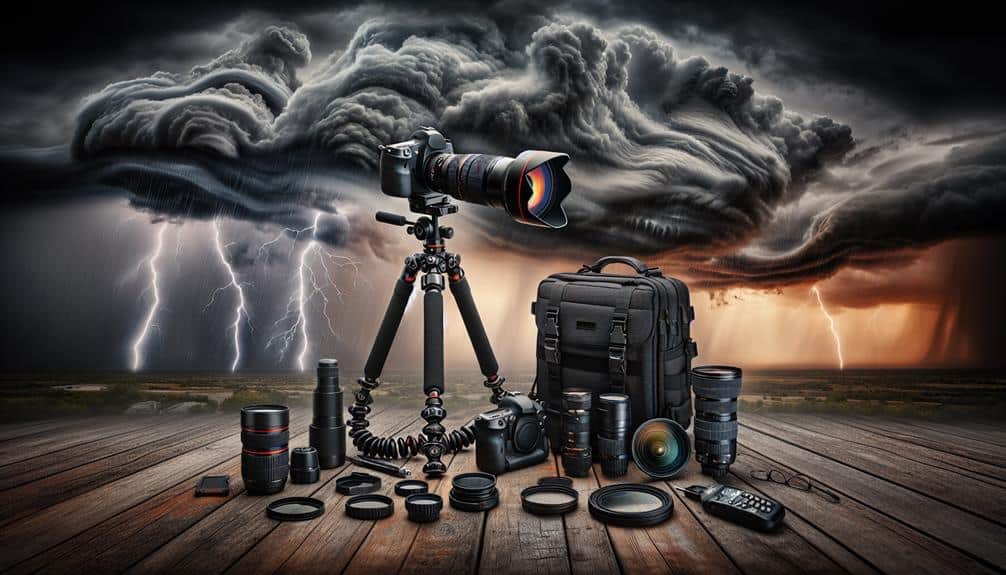
Capturing the raw intensity of storms requires sturdy and versatile camera equipment designed to withstand extreme conditions. Our camera setup needs to be both durable and adaptable to capture high-quality images despite challenging weather.
Here are some essential components:
- Weather-sealed camera body: A camera that's resistant to dust and moisture is necessary. This guarantees our equipment remains operational even in the harshest environments.
- Lens filters: Using UV and polarizing filters not only protects our lenses but also enhances image clarity by reducing glare and increasing contrast.
- Robust tripod: Tripod stability is vital when shooting in high winds. A heavy-duty tripod with spiked feet can anchor us firmly to the ground, minimizing camera shake.
Adjusting camera settings appropriately is important. We need to use fast shutter speeds to freeze motion and wide apertures for low-light conditions. Effective lighting techniques, like using natural light to our advantage, help in creating dramatic storm images.
Frequently Asked Questions
How Can I Ensure My Vehicle Is Storm-Ready?
To guarantee our vehicle is storm-ready, let's prioritize emergency supplies and routine maintenance. A thorough vehicle inspection and meticulous preparation are essential. This strategic approach maximizes safety, granting us the freedom to pursue our passion with confidence.
What Are the Best Practices for Staying Informed About Changing Weather Conditions?
We should use dependable weather apps and set alerts to stay updated on changing conditions. Additionally, practicing emergency plans and conducting regular drills guarantees we're prepared for any scenario. Staying informed helps us maintain our freedom safely.
How Do I Communicate With My Team During a Storm?
Coincidentally, during a recent storm, we relied on team communication via two-way radios and mobile apps. Emergency protocols guaranteed we stayed updated with weather updates through real-time data from technology options like radar and satellite feeds.
What Insurance Considerations Should Storm Chasers Keep in Mind?
We should evaluate coverage options and premiums to make sure we're adequately protected. Liability protection is important in case of accidents, and understanding the claims process helps us navigate potential issues efficiently while maintaining our freedom to chase storms.
What Precautions Should I Take When Encountering Downed Power Lines?
When encountering downed power lines, we should follow strict safety protocols. First, maintain a safe distance. Second, avoid contact with anything touching the line. Third, report the hazard to emergency response teams for proper handling.
